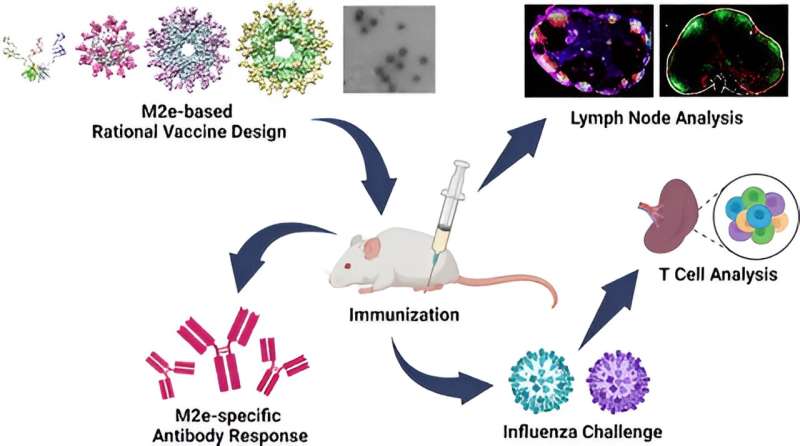This article has been reviewed according to Science X's editorial process and policies. Editors have highlighted the following attributes while ensuring the content's credibility:
fact-checked
peer-reviewed publication
trusted source
proofread
Nanoparticle flu vaccine design shows promise in early tests

Existing flu vaccines provide only limited, seasonal protection because they target highly changeable proteins on the virus. Scripps Research scientists have now designed a vaccine that should work broadly against influenza A strains—one of the two types of flu virus that normally circulate in humans.
The new vaccine design, described in a paper titled "Single-Component Multilayered Self-Assembling Protein Nanoparticles Displaying Extracellular Domains of Matrix Protein 2 as a Pan-influenza A Vaccine" in ACS Nano on November 21, uses a relatively unchanging influenza A protein fragment, M2e, and presents it on self-assembling nanoparticles to better engage the immune system.
The vaccine's strong results in initial animal tests point to the possibility of a universal flu vaccine that provides long-term protection against serious illness from both ordinary and novel flu strains.
"This experimental vaccine has the potential to protect against diverse seasonal influenza A strains as well as future emergent strains that could cause pandemics," says study senior author Jiang Zhu, Ph.D., an associate professor in the Department of Integrative Structural and Computational Biology at Scripps Research.
The co-first authors of the study were postdoctoral research associate Keegan Braz Gomes, Ph.D., and staff scientist Yi-Nan Zhang, Ph.D., both of the Zhu Lab.
M2e is the small, external portion of M2, a protein embedded in the outer envelope of flu viruses. Because M2 has a critical role in the flu virus life cycle, it and M2e are largely the same from one flu A strain to the next. The fact that it is so well "conserved" across strains suggests that M2e could be a good target for a broadly effective flu vaccine.
In practice, targeting M2e has been a challenge. Past vaccines targeting M2e have not shown strong and durable protection, mainly because this protein fragment is too small to engage the immune system very effectively. The new vaccine from Zhu and his team is designed to overcome this drawback.
Like other vaccines developed by the Zhu Lab in recent years—including HIV, SARS-CoV-2, and Hepatitis C virus vaccines—the new vaccine presents viral proteins to the immune system not as individual loose protein copies but, rather, mounted on large nanoparticles. This nanoparticle-based design "looks" to the immune system more like a real virus, which leads to greater immune stimulation. The nanoparticles are self-assembling, highly stable, and easy to manufacture using biotech methods; each is studded with dozens of copies of the targeted viral protein.
In the new study, the researchers began with a nanoparticle-based design that used a version of M2e from a human-infecting influenza A strain, H1N1. This protected ten out of ten mice from sequential, high-dose exposures to live H1N1 virus and a very different influenza A strain called H3N2. In contrast, unvaccinated mice rapidly succumbed to viral exposure, as did most of the mice vaccinated with a non-nanoparticle version of M2e.
The team obtained similarly promising results for a pandemic-stopper design featuring a mix of M2e proteins from human, bird and pig influenza A viruses. They also found that their M2e-bearing nanoparticles remained in mouse lymph nodes, stimulating immune responses for many weeks, whereas non-nanoparticle-mounted M2e proteins were cleared from lymph nodes within hours of injection.
"This suggests a very persistent engagement with the immune system, which we hope will enable our design to overcome the durability issue seen for earlier M2e-targeted vaccines," Zhu says.
Overall, he adds, the results demonstrate the potential of the M2e nanoparticle-mounted design to protect broadly against influenza A viruses.
A future version, Zhu says, might add influenza B M2e proteins, leading to a true pan-influenza vaccine. Such a vaccine, if proven effective, could significantly hobble influenza's ability to cause serious illness and mass-mortality pandemics—tending to reduce it to something like a mild cold even in high-risk cases.
Uvax Bio, a spin-off vaccine company from Scripps Research, employs proprietary platform technology invented in Dr. Zhu's lab at Scripps Research to develop and commercialize prophylactic vaccines for various infectious diseases. Zhu and the company are now considering their options for translating the new M2e design into a commercial flu vaccine.
More information: Keegan Braz Gomes et al, Single-Component Multilayered Self-Assembling Protein Nanoparticles Displaying Extracellular Domains of Matrix Protein 2 as a Pan-influenza A Vaccine, ACS Nano (2023). DOI: 10.1021/acsnano.3c06526
Journal information: ACS Nano
Provided by The Scripps Research Institute




















